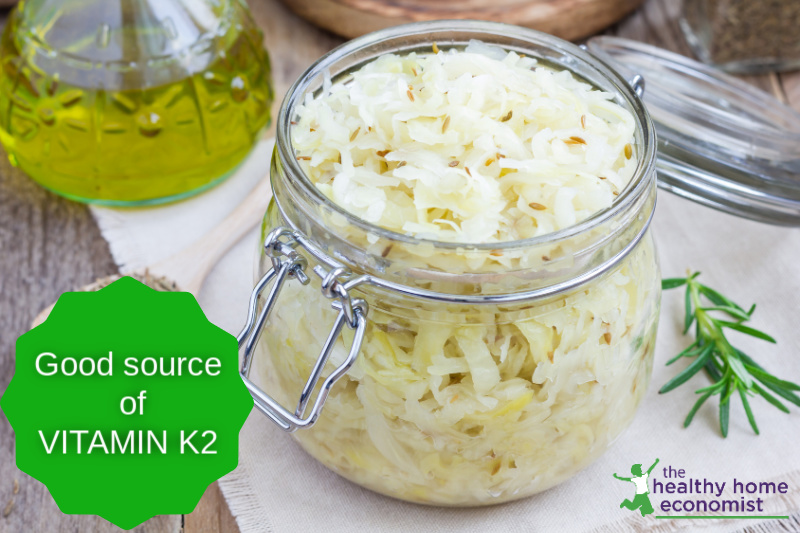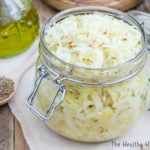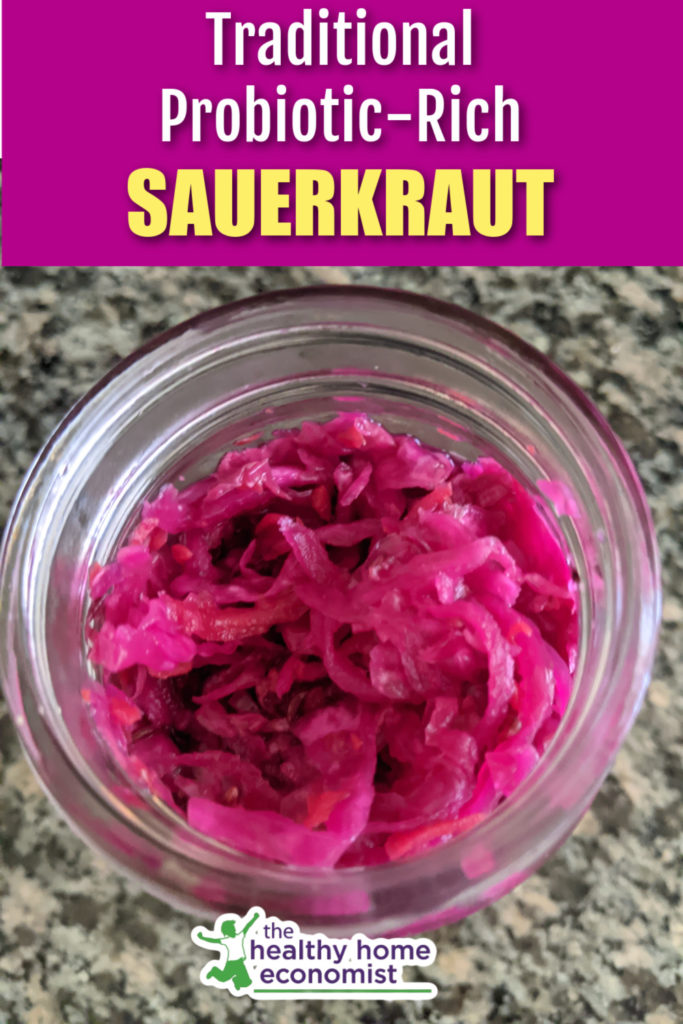Recipe and detailed video instruction on how to make traditional sauerkraut that is loaded with probiotics and Vitamin K2 for better digestion and health. 
By popular demand, the process of making homemade sauerkraut is explained and demonstrated in the two video lessons below. The written recipe is also provided by those who wish to dive right in.
This traditional food is probiotic-rich and very nutrient-dense unlike the vinegar-packed sauerkraut wanna-be’s at the store.
The first video covers a brief history of sauerkraut and what you need on hand to make it. The second video covers how to make sauerkraut yourself quickly and easily in your kitchen.
The sauerkraut recipe I use is based on the Nourishing Traditions method.
Benefits of Fermenting Cabbage
Eat small amounts of this probiotic-rich condiment with cooked foods to improve digestion and assimilation.
Remember that fermenting does not reduce the goitrogens (thyroid suppressing substances) in the cabbage. So, if you have thyroid issues, you may wish to consider avoiding this particular condiment.
If your thyroid status is good and you eat plenty of iodine-rich foods like grassfed butter, then sauerkraut is a healthy addition to the diet.
Loaded with Vitamin K2
Did you know that properly cultured cabbage contains a significant amount of natural Vitamin K2? This is an elusive nutrient that is very hard to get in the diet. It is essential for strong bones and healthy teeth.
The USDA reports that one cup of sauerkraut contains 81 mcg. No doubt this is the commercial, pasteurized stuff that the USDA is testing too.
I would venture to suggest that making raw sauerkraut yourself and fermenting properly would potentially contain larger amounts.
Natural Remedy for Reflux
Another bonus of eating raw fermented cabbage is that it is a natural way to prevent acid reflux. Simply eat a mouthful or two a few minutes before the start of a meal.
Want to experience these benefits for yourself? Two detailed video lessons are included with the recipe below.
Tip: Be sure to wear an apron when you make this dish as you will see in the video! ?
Why don’t you try it today! You will never go back to the pasteurized, shelf stable sauerkraut at the store!

Homemade Sauerkraut Recipe
Basic recipe for homemade sauerkraut as traditionally made as a live cultured food loaded with probiotics and enzymes to aid digestion and absorption of nutrients.
Ingredients
- 1 green or purple cabbage medium size, preferably organic
- 4 Tbl liquid whey
- 1 Tbl caraway seeds
- 1 Tbl sea salt
Instructions
-
Core and chop cabbage. Place all the chopped cabbage and other ingredients together in a large sturdy bowl.
-
Pound the juices out of the cabbage thoroughly with a kitchen pounder of some kind for a full 10 minutes.
-
Tightly pack the cabbage into a one quart mason jar leaving at least 1 inch of space at the top. Tightly seal with the lid.
-
Leave on the counter for 3 days and then refrigerate.
-
The flavor of the homemade sauerkraut improves over time. It will last many months in your refrigerator or cool cellar.
Recipe Video

References
(1) Vitamin K2 in Sauerkraut
(2) Nourishing Traditions
More Fermented Food Recipes
Love this sauerkraut recipe? Try these other delicious fermented foods and drinks below and unleash the power of a traditional diet in your home.
How to Make Fermented Lemonade
How to Make Orangina
Mango Chutney Recipe
Homemade Apricot Butter
Fermented Potatoes
Probiotic Corn Relish
How to Make Fermented Cilantro Salsa
Beet Kvass Recipe








If this really salty? If so, is it possible to make a salt-free sauerkraut that is still rich in probiotics?
I don’t find it salty. You can try it with whey only and see if it works.
Sauerkraut is actually fermented for 3 weeks, not 3 days.
The flavor does improve over time, for sure. But if you try this recipe, you will see that it is plenty fermented after a few days!
The reference for the vitamin K2 content actually only talks about “vitamin K”, which includes both forms. Then it goes on to talk about how when you boil and drain cabbage, the vitamin K content only decreases slightly. That would suggest that most of the vitamin K found in sauerkraut is actually just K1 that was already there in the cabbage.
I’m not familiar with the USDA database, so I had a quick look at Chris Masterjohn’s vitamin K database instead. This lists 4.8µg/100g K2 and 25.1µg/100g K1. Maybe homemade sauerkraut would have a bit more K2, but overall it still looks more like a mediocre source of this nutrient to me.
Dear Sarah, I’m very excited to make this. Thank you kindly! I’d like to know if the probiotic benefits are the same after only four days as they are after six months or does just for the flavor improve while the probiotic benefit stays the same after six months?
Secondly, it’s my understanding good should be kept away from light in cupboards or using miron violet glass. May I ask why you leave it out for four days without protecting the sauerkraut from light?
Thank you,
Monica
A few days out on the kitchen counter (away from direct light of course) is fine and not damaging. The probiotic value does increase over time as it gets tarter and more flavorful. Excited to have you try it!
I just made my first batch, left it on the counter 3 days, opened it to taste, put the lid back on and in the refrigerator. Afer a day in the fridge I took it out but can’t get the lid off now. I think it formed a suction. what do I do?
Sarah, how long exactly is this safe to eat after making? I know you said “many months,” but I made mine 2 years ago. A little was used at some point within the year that I made it, but I’d just had a baby & forgot it on the bottom shelf of our fridge. When I realized it was still there, I was hesitant to eat any. It was made per this recipe on 10/19/15.
If you open it up and there’s no mold and it smells ok, its probably fine. The longest I’ve had mine refrigerated before it was used up was 6 months. Make your best judgment on that.
Kindly how much does this medium cabbage weigh?
Thanks in advance a
It’s about the size of a large grapefruit.
I love this! I cannot begin to express how helpful it is to have a video to guide those who are trying to make the recipe along the way. This recipe looks great as well – can’t wait to try this at home!
Hello Sarah:
I am confused about how long to ferment sauerkraut on the counter. i followed your recipe and watched your video. It is November in the Northeast. My home is 68-72 degrees on average. My sauerkraut has been on the counter for 4 days now. Some recipes call for fermenting it a minimum of 20 days outside of the fridge. Why do you suggestion a maximum of 4 days followed by putting it in the fridge? Does this improve the health benefit? Do you have any updates to your recipe?
Thank you for all your helpful tips and instruction. Your videos have motivated me to introduce traditional foods to my diet????
Anna
How long you can leave it out really depends on the temperature. If your home is 68-72F, then 4 days is plenty and then you move it to the fridge or a cool cellar. Sauerkraut improves with flavor over time … it really takes a full 6 months to get the full flavor, but most of us eat it up long before then 🙂 So glad the videos have helped you!!